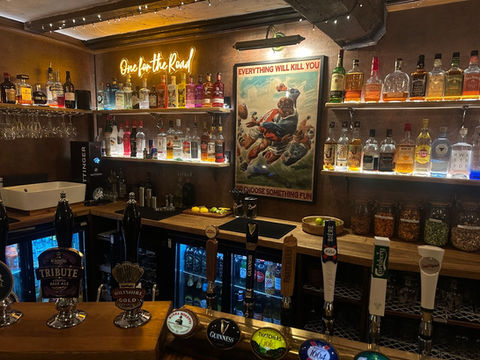About the Inn
A Timeless Retreat in the Heart of Faringdon
Our Inn is proudly managed by a team passionate about creating memorable experiences for locals and visitors alike. From our award-winning 2AA Rosette Restaurant to our two distinctive bars—JJ’s Wine & Cocktail Bar and our classic pub bar with live music every Saturday—we’re more than just a place to stay. Our core values revolve around authenticity, community, and exceptional service. Here, we aim to provide a welcoming atmosphere that celebrates the rich character of Faringdon, while delivering a high standard in food, drink, and accommodation. We have parking available to patrons to the rear of The Crown. Accessable adjacent to the Morisons Store. We also have two 7kw type two electric chargers in our car park.

More about Faringdon
The Town
Surrounded by the scenic charm of the Oxfordshire countryside, Faringdon offers a rich blend of attractions and outdoor activities for visitors. Discover picturesque walking trails through rolling hills and ancient woodlands, or take a stroll to Faringdon Folly Tower for panoramic views stretching across the Cotswolds. The town itself is brimming with independent shops, local markets, and cosy cafés, perfect for a leisurely day of exploring. Just a short drive away, you’ll find historic landmarks like White Horse Hill and quaint neighbouring villages that offer a taste of local heritage. Faringdon is also just 15 minutes from The Cotswolds and villages like Burford, Bibury and Lechlade. Whether you’re a nature lover, history enthusiast, or simply looking to unwind, Faringdon has something unique to offer every visitor.




History
Established in 1492
The oldest part of the building, The Pub, dates back to 1492. The Old Crown Coaching Inn is steeped in fascinating stories from centuries past, especially during the tumultuous period of the English Civil War. As a key location in Faringdon, the Inn served as a gathering point for Royalist supporters and soldiers loyal to King Charles I. Legend has it that Judge Jeffreys, known for his infamous “Bloody Assizes,” held court here, adding a darker note to the Inn's storied past. Beneath the Inn, a series of tunnels was said to connect with key sites around Faringdon, offering secretive passageways during times of siege and turmoil. These hidden tunnels and tales of clandestine meetings lend an air of intrigue to The Old Crown, weaving a rich tapestry of local history that visitors can still feel today.
Where our story began.
In December 2021, The Old Crown Coaching Inn in Faringdon underwent an extensive renovation to rejuvenate its historic charm while introducing modern amenities. The refurbishment included a comprehensive overhaul of the interior and exterior, transforming the establishment into a sought-after venue. The project encompassed the creation of an 80-seat restaurant, a new cocktail and wine bar, an al fresco dining courtyard, and the renovation of 14 guest rooms. The addition of a state-of-the-art kitchen facilitated the introduction of a fine dining experience under the leadership of award-winning Head Chef Sam Squires.

What you will find now
A Place for All
The Crown has a space to suit every need, combining history, charm, and modern touches. Step through the front door into The Pub, where traditional exposed beams, a roaring open fire, and cosy candlelit tables and three intimate and private snugs that create the perfect setting to unwind with a drink, enjoy live music, or catch the latest rugby match with friends. With a range of local and country favourite ales, lagers, spirits and wines, there is plenty to choose from. Alternatively, wander through the historic horse-and-carriage archway into our picturesque Courtyard, where you'll discover JJ's Wine and Cocktail Bar. JJ’s boasts an extensive cocktail menu, a carefully curated wine list, and a warm, intimate atmosphere perfect for relaxed evenings or lively celebrations. From there, ascend to our award-winning Ballroom Restaurant, a breathtaking space with elegant décor, high ceilings, and a menu that showcases the very best of local and seasonal produce, ideal for everything from casual dining to grand occasions. Wherever you find yourself, The Crown promises an experience to remember.



The Bedrooms
It's more than just a room.
Our beautifully appointed bedrooms offer the perfect retreat, whether you're staying for a special occasion, a weekend getaway, or a peaceful night's rest after exploring the area. To make the most of your experience, we highly recommend joining us for dinner in our award-winning Ballroom Restaurant, where seasonal menus and locally sourced ingredients promise an unforgettable meal. And no stay would be complete without indulging in our cooked-to-order breakfast, a true highlight of The Crown. Using only the finest local produce, each dish showcases the quality and provenance of our ingredients, from freshly baked bread to free-range eggs and artisan sausages. Let us set you up for the day ahead with a breakfast that’s as satisfying as it is memorable.
We look forward to welcoming you soon.
We look forward to welcoming you soon to The Old Crown Coaching Inn, where our warm hospitality and inviting atmosphere create the perfect setting for any occasion. Whether you're visiting our cosy bars for a drink, dining in our award-winning 2AA Rosette restaurant, or enjoying a relaxing stay in one of our beautifully appointed rooms, you'll find the charm and comfort that makes every visit special. Join us and experience all that our inn has to offer – we can't wait to host you!

Art & Design
Carefully Curated
The Old Crown Coaching Inn in Faringdon proudly displays limited edition prints by contemporary British artist Gabriella Anouk, including her renowned "Lucky Cat" piece. This artwork draws inspiration from the iconic Maneki-neko figures that adorn Gordon Ramsay's Asian-inspired restaurant, Lucky Cat, in Mayfair. Anouk's "Lucky Cat" features intricate details and incorporates gold leaf, reflecting the traditional ceramic statues' shiny elements. These prints are showcased in select rooms and the Ballroom, adding a modern artistic touch that harmonizes with the Inn's blend of historic charm and contemporary elegance






